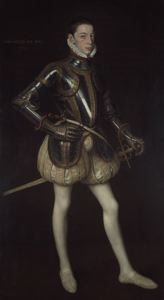
This image is restricted, permission must be requested for reproduction. Downloading for commercial use is prohibited. If you wish to obtain rights to reproduce this image please see our Rights and Reproductions page.
Anthonis Mor
(1517 - 1576)
Portrait of Alessandro Farnese
Retrato de Alessandro Farnese
1561
Oil on canvas
71 3/8 x 38 7/8 in. (181.3 x 98.7 cm)
Century: 16th Century
Credit Line: Meadows Museum, SMU, Dallas. Algur H. Meadows Collection, MM.71.04
Accession Number: MM.71.04
More Information
Visual Description
This painting, approximately 6 feet tall by 3.25 feet wide, is a full-length portrait of a young man (Portrait of Alessandro Farnese). He is dressed in armor and stands alone against a dark, almost black background. His face is youthful with no trace of a beard. He has a long, straight nose, dark arched eyebrows and close cropped hair, and brown eyes that look directly out at the viewer. His expression is serious and unsmiling. He is turned slightly to the viewer’s right in a three-quarter view; his right hand rests on his hip and his left hand on the hilt of a sheathed sword. His feet are apart, his weight on his straight right leg and his left leg turned sideways and outstretched.The armor closely fits his upper body and arms, with two rounded front panels extending from his waist to mid-thigh. The armor extends upward to his jawline where a white ruffled collar frames his face. His matching gauntlets are intricately jointed to allow his fingers to bend. The armor is made of highly polished black metal, decorated with bands of finely worked gold; each plate is edged in red piping. Below the armor, his hips and thighs are clothed in pantaloons composed of strips of gold-patterned fabric over a lining of white silk. The pantaloons balloon out from the waist and then nip in to his legs about six or seven inches above the knee. He wears pale gray stockings on his long, slim legs and soft gold-colored slippers on his feet.
Near the top left of the painting, the artist, Anthonis Mor, has inscribed in red Anno Etatis XVI, and centered below it, the date 1561. The painting’s surface is glossy and smooth with brushwork that is virtually invisible.











